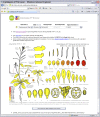Web-queryable large-scale data sets for hypothesis generation in plant biology
- PMID: 19401381
- PMCID: PMC2685637
- DOI: 10.1105/tpc.109.066050
Web-queryable large-scale data sets for hypothesis generation in plant biology
Abstract
The approaching end of the 21st century's first decade marks an exciting time for plant biology. Several National Science Foundation Arabidopsis 2010 Projects will conclude, and whether or not the stated goal of the National Science Foundation 2010 Program-to determine the function of 25,000 Arabidopsis genes by 2010-is reached, these projects and others in a similar vein, such as those performed by the AtGenExpress Consortium and various plant genome sequencing initiatives, have generated important and unprecedented large-scale data sets. While providing significant biological insights for the individual laboratories that generated them, these data sets, in conjunction with the appropriate tools, are also permitting plant biologists worldwide to gain new insights into their own biological systems of interest, often at a mouse click through a Web browser. This review provides an overview of several such genomic, epigenomic, transcriptomic, proteomic, and metabolomic data sets and describes Web-based tools for querying them in the context of hypothesis generation for plant biology. We provide five biological examples of how such tools and data sets have been used to provide biological insight.
Figures


References
-
- Alonso, J.M., et al. (2003). Genome-wide insertional mutagenesis of Arabidopsis thaliana. Science 301 653–657. - PubMed
-
- Aoki, K., Ogata, Y., and Shibata, D. (2007). Approaches for extracting practical information from gene co-expression networks in plant biology. Plant Cell Physiol. 48 381–390. - PubMed
-
- Arabidopsis Genome Initiative (2000). Analysis of the genome sequence of the flowering plant Arabidopsis thaliana. Nature 408 796–815. - PubMed
-
- Axtell, M.J., Jan, C., Rajagopalan, R., and Bartel, D.P. (2006). A two-hit trigger for siRNA biogenesis in plants. Cell 127 565–577. - PubMed
-
- Baerenfaller, K., Grossmann, J., Grobei, M.A., Hull, R., Hirsch-Hoffmann, M., Yalovsky, S., Zimmermann, P., Grossniklaus, U., Gruissem, W., and Baginsky, S. (2008). Genome-scale proteomics reveals Arabidopsis thaliana gene models and proteome dynamics. Science 320 938–941. - PubMed
Publication types
MeSH terms
LinkOut - more resources
Full Text Sources

